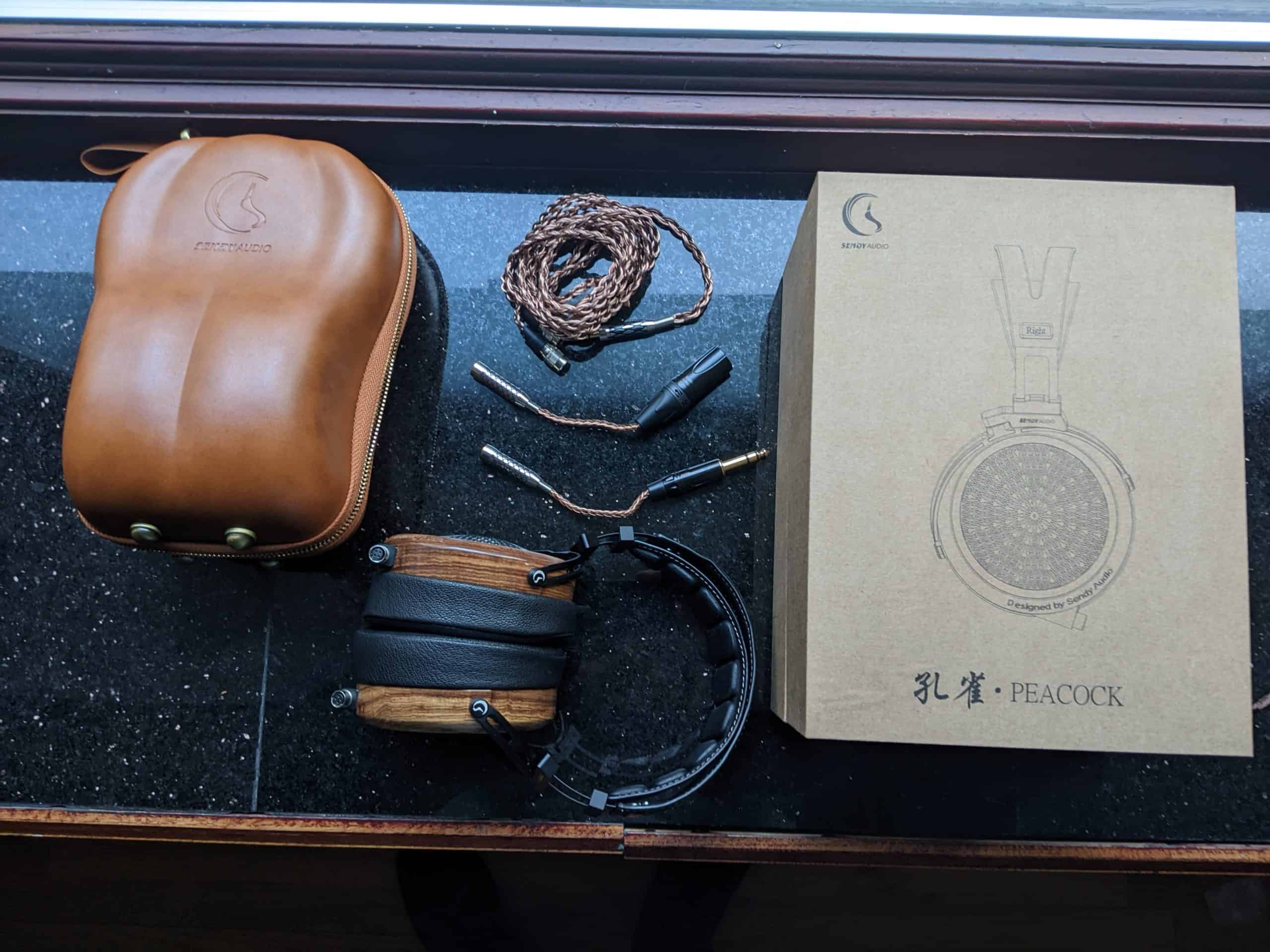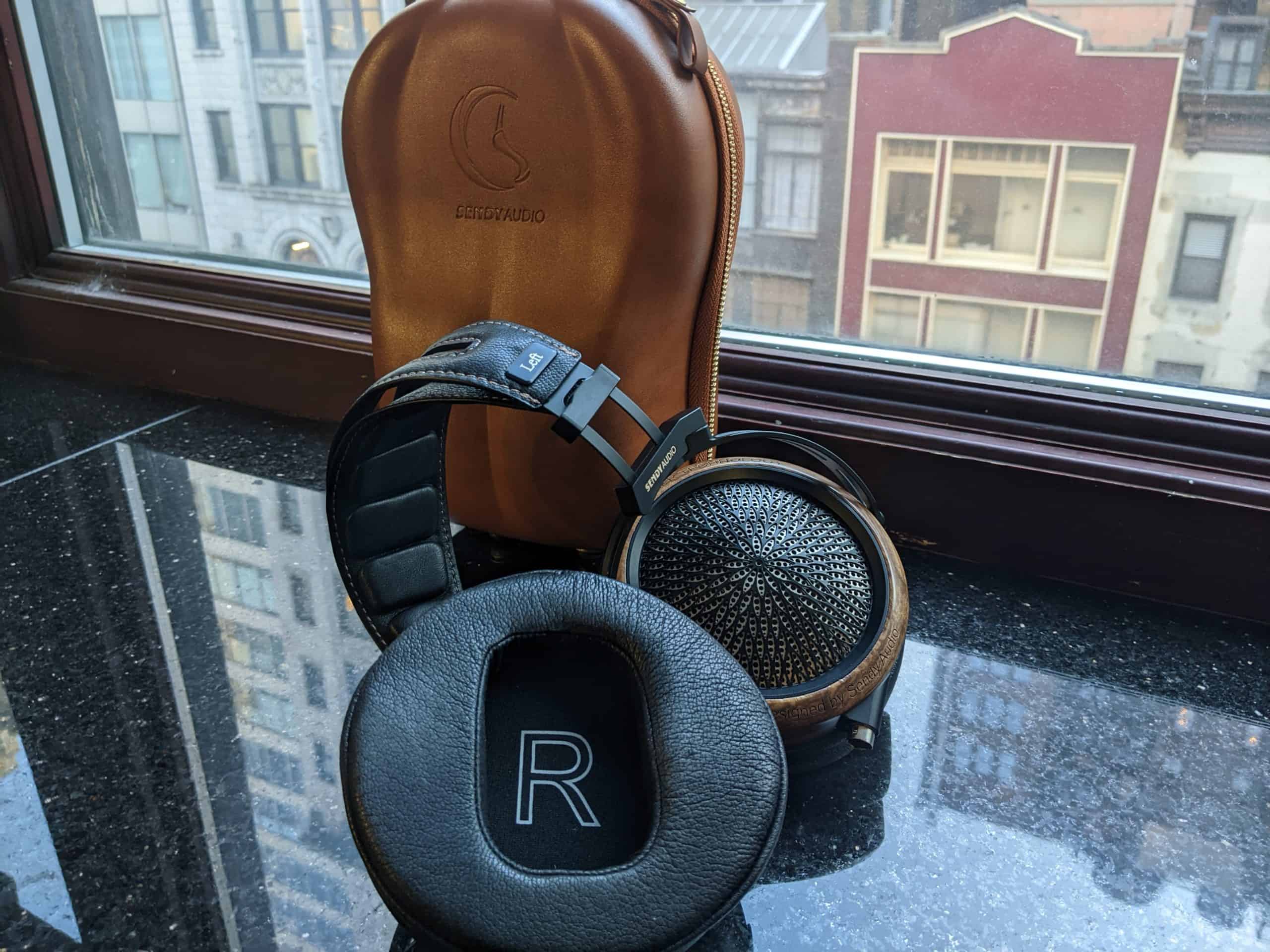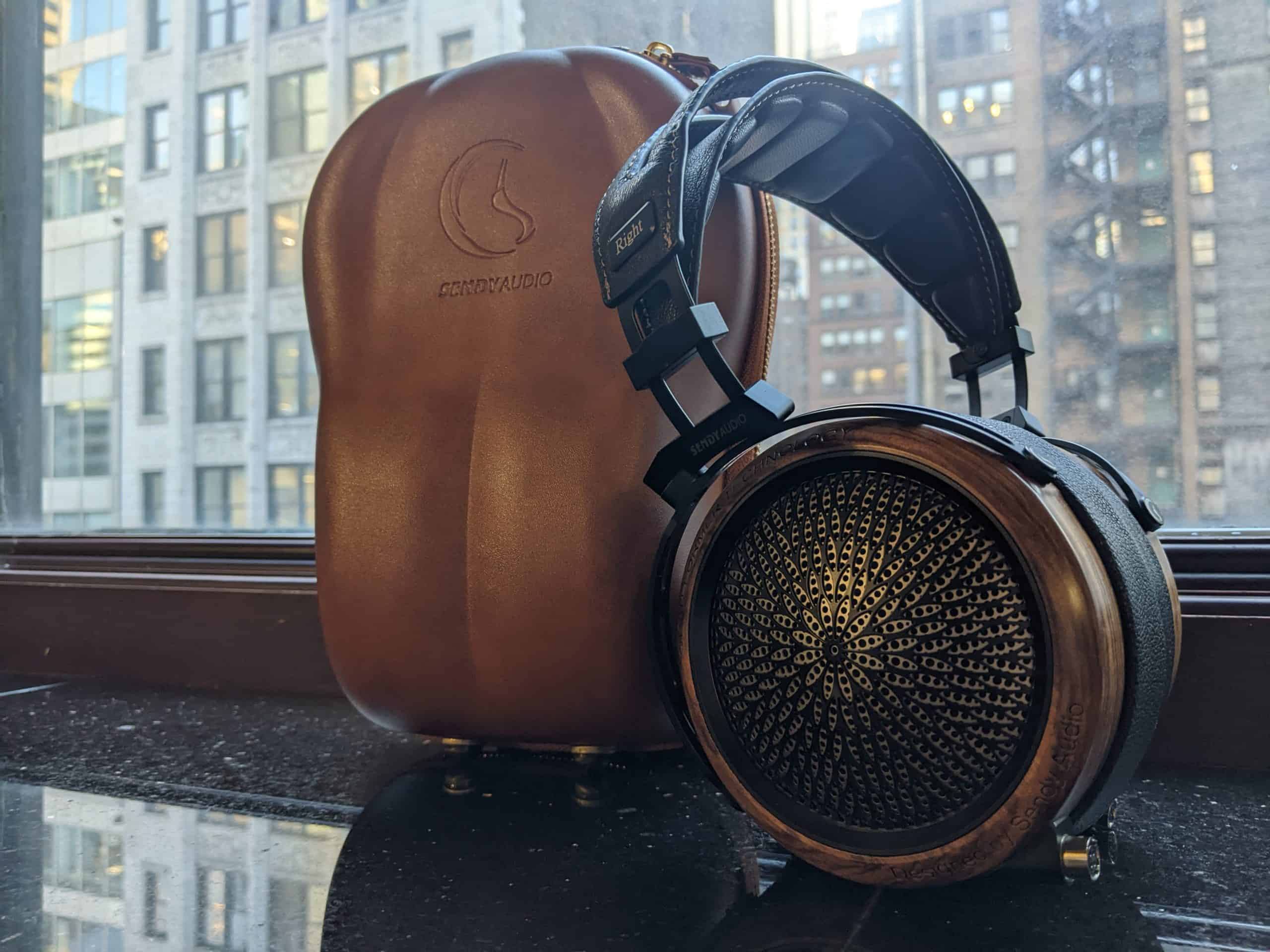Sendy Audio Peacock Review
If you’re here because you’re browsing around Sendy Audio Peacock reviews, you might be as confused as I was when reading the highly polarized opinions surrounding the headphone. I recently got the chance to review the Sendy Apollo, a $500 open back planar headphone from the company that I found pretty laid back and pleasant. With the Peacock standing at $1499, I have higher expectations, and a curiosity regarding its love-hate reputation. Let’s take a look inside the box, go over some design, and most importantly, see what this Sendy flagship sounds like.
What’s In the Box?

- Sendy Audio Peacock Open-Back Headphones
- 4 pin to 4.4mm Balanced cable
- 4.4mm to 4 pin XLR adapter
- 4.4mm to 6.35mm Adapter
- Hard Carrying Case
Look and Feel
As is all things Sendy, the Peacock is a wooden headphone with a steel mesh acoustic grill on its open-back cans. It features a manual adjustment suspension headband made of embroidered goat skin, with the structural frame of the headband made out of aviation aluminum. Maybe it wasn’t Sendy’s intent, but the Peacock’s stylistically seems like an apex cottage-core headphone.

Though I’m a fan of the Peacock’s rustic but also somewhat flashy appearance, I had some troubles with the fit at first. I had a hard time getting a good seal on the right side of my head when I wore it for the first time. After a fair amount of nudging and adjustment, I finally got a fit I was happy with. Once I figured it out the first time, I didn’t have the issue again. The fact that I had a seal issue on only one side of my head makes me think it’s an issue that will be particular to head shape and size: some people might struggle a little like I did, others might get it right on the first try.
The Sendy Peacock is pretty heavy, coming in at 578 grams, and also has a relaxed fit with minimal headband pressure. Now, there’s nothing inherently wrong or uncomfortable with this, but I find that it decisively makes the Sendy Peacock the type of headphone you’ll have to wear while sitting down at a desk. Headband pressure can technically be increased by bending its aluminum frame, but I didn’t feel comfortable doing this with the demo unit that was kindly given to me.
Last note I want to make here is that the Peacock comes with an awesome carrying case. If you’re familiar with Sivga, it might look familiar: hard and protective, real brown leather, and if I may say, dummy thicc and bodacious.

Design and Technical Specs
The Sendy Peacock makes use of what Sendy calls Quad-Former technology. The planar driver is composed of two magnets, with two coils on each side of the driver’s diaphragm. According to Sendy, this driver configuration leads to more uniformity, accuracy, and lower distortion. The highly damping material(s) used in the diaphragm is supposedly responsible warm sounding vocals and a “solid” bass response. Lastly, the steel grille on the backs of the cans does more than just add an aesthetic flourish: the layered design creates reflections that contribute to the Peacock’s tuning.
| Spec | Sendy Audio Peacock |
| Operating Principle/Driver | Open Back 88mm Planar Driver |
| Impedance | 50 ohms |
| Sensitivity | 103 dB |
| Frequency Response | 20 Hz – 40 kHz |
Soundstage
If I had to narrow the Peacock’s appeal down to a couple of specific characteristics, I would choose its sound stage and imaging, followed by its low end. Though I found the fit a bit unusual, I think it plays a significant role in the Peacock’s vivid spatial expression, for a few reasons. Firstly, the 88mm driver has a large surface area that seems like it would outsize most listener’s ears, as it did mine. I felt the driver’s vibrations drenching my pinnae and sliding behind my ears. Secondly, my ears were positioned more forwardly in the headphone chamber when I finally found a good, sealing fit. Considering both of these variables, I don’t think it’s a coincidence that the Peacock presented with an excellent depth, providing me with constant over-the-shoulder sensations and, at times, positioning parts as if they were directly behind my head. Width and height were abundantly present as well, with hard pans showing a considerable figurative distance from my ear, but the star of the Peacock’s imaging and staging is its depth and “from-behind” qualities.
Lows
Though I generally read companies’ self-reported outcomes of technical designs with a good deal of scrutiny and some degree of skepticism, I have to admit that Sendy picked the perfect word when they refer to the Peacock’s bass timbre as “solid.” Like other releases I’ve tried from the company, sub bass is subjected to a significant roll off – though less so than the Apollo, for example. The bulk of low end expression is delegated to mid and high bass, which play an important role in the Sendy’s overall balance. Though there are moments in the mid range and treble where I found the Peacock could sound cluttered on certain genres, the bass response was a constant anchor in the signature, maintaining speed and sharp definition regardless of whatever music I played through it. The attenuated subs give it a lean quality, while the moderate mid bass presence with high bass compliments gave it a touch of slam and what I would call knock.
Mids
Alright, I’m pretty sure the mid range (and mid treble, more on that shortly) is what earned the Sendy Peacock a bit of controversy in its initial reviews. However, I think there’s a more nuanced take to be had with the misunderstood Peacock. There’s a slightly cupped sound to the mid range, and a bit of bloom occurring between the high bass and low mids. If you want to listen to busy, aggressive mixes, the Peacock is not the way to go. Mid range reverbs, for example, find an emphasis that can clutter quickly.
On the other hand, there’s a pretty, dark, water-color-esque quality to the mids on quieter, more laid back tracks. Piano pieces sounded great, with warm notes gently blending as they would in a large concert hall. Gently played drums took on a soothing, thumping quality that seemed colored by the semi-cupped sound in the low mids. Vocals were generally softened without overly emphasized fundamentals making them sound muddy. In short, the Peacock’s loose and warm mid range is excellently suited for more minimalist, acoustically recorded genres for the same reasons that it is not suited for heavier genres with dense and aggressive mixes.
Highs
The Peacock has basically confirmed for me what the Sendy house-sound is for their treble balances; I suspect the highs will sound familiar to any Apollo or Aiva owners. Mid treble brings the bulk of brightness and lift to the balance, while low treble plays more of supporting role and stays modestly attenuated. This tuning makes the treble profile sound fairly separate, perhaps detached, from the rest of the warm balance – I mean this as more of a neutral observation rather than as a positive or a negative. Electric guitars jump into mixes with a good deal of harmonic intensity, which I found to be a nice, if risky, compliment to the meatier qualities they find in the high bass and low mids. A surprising high treble extension provides a welcome, airy lift to the Peacock’s overall balance, coaxing air out of the softness imparted on vocals in the mid range.

Overall
Sendy’s house sound seems to aim for an easy-listening experience in a unique way, which is something I can appreciate. If I had to pick what major enhancements the Peacock offers over the Sendy Apollo or Aiva, I would pin it on its sound stage and general spatial abilities. As for its tuning, I honestly don’t understand some of the hate that it’s received. The Sendy Peacock may not being the most eclectic headphone, but it was exceedingly pretty and pleasant on quieter, more mellow tracks. It might not be right for everyone, but there’s an obvious niche for it that few other headphones can adequately fill.
P.S. If you find yourself with the Sendy Peacock, try running it through a tube amp if you have one. I didn’t try this, but its warm, gentle signature seems like it would be an excellent match.
The Sendy Peacock can be purchased here from Audio46.
MAJORHIFI may receive commissions from retail offers.








